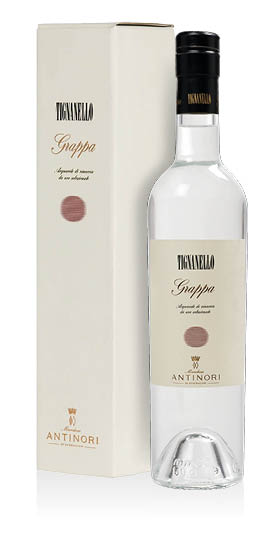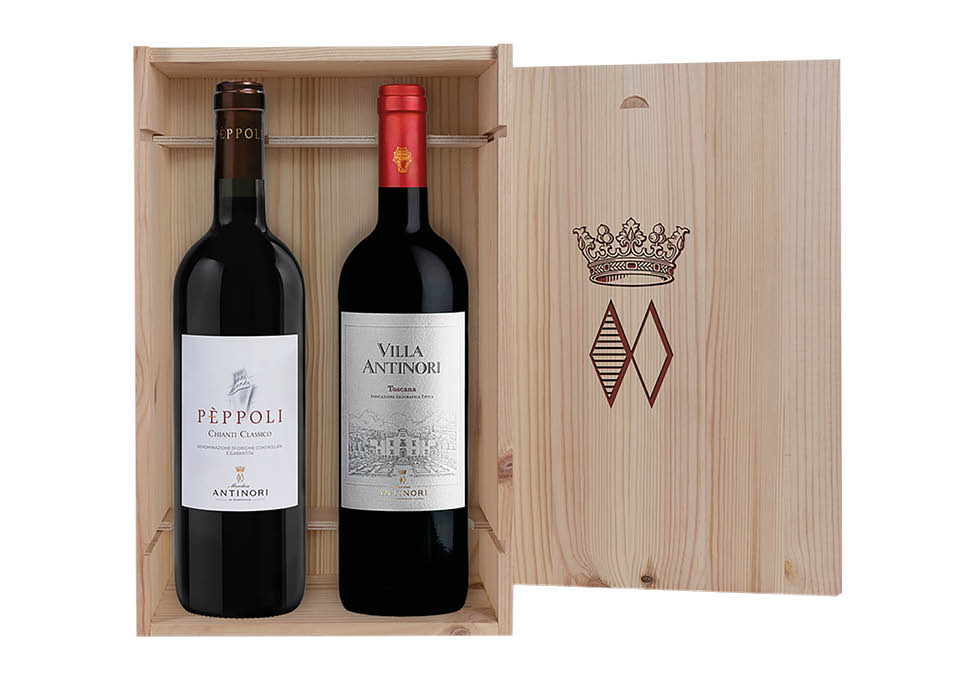Marchesi Antinori
The Marchesi Antinori are among the greatest protagonists in the history of Italian wine. For more than six hundred years and 26 generations, the Antinori family has been dedicated to wine production. It was in 1385 that the progenitor of the family, Giovanni di Piero Antinori, joined the Florentine Arte dei Vinattieri as an apprentice. Gradually the production of wine, together with the silk trade and banking, became a successful business. In 1543, Alessandro Antinori was one of the richest men in Florence and as early as the 1700s Antinori wines were being exported to England. In 1861 Antinori was given the title of Marquis and at the end of the 19th century the current Marchesi Antinori was established. Exports continued to increase, Marchesi Antinori wines had now also landed in the United States and Argentina. In 1940, the family began expanding the estates in Tuscany and bought the Castello della Sala in Orvieto, also starting to produce white wines. Piero Antinori inherited the company from his father Niccolò Antinori and is the honorary president of the company, currently presided over by the eldest daughter of the Marquis: Albiera Antinori. Over the centuries the Antinori family has always managed the company directly, going through history with respect for tradition and the territory. The ability to see, the continuous experiments in the vineyards and in the cellar, the farsightedness and the constant search for quality have led the Marchesi Antinori to ride the centuries in the name of expansion, always investing in new projects and cellars outside the estates history in Tuscany and Umbria and continuing to produce quality wines also in other regions of Italy and abroad.
Marchesi Antinori Red Wine
Marchesi Antinori red wines are appreciated all over the world. The best known and most renowned are the Brunello di Montalcino Pian delle Vigne, the Chianti Classico Pèppoli, the Chianti Classico Riserva Villa Antinori, the Chianti Classico Gran Selezione Badia a Passignano and the two great red wines Tignanello and Solaia. But what are the characteristics of these unique red wines and of the estates where they are produced? One of the Marchesi Antinori's greatest red wines is Brunello di Montalcino, produced on the Pian delle Vigne Estate. The estate is located in the south-west area of Montalcino, in the province of Siena, and is made up of 184 hectares, of which 65 are planted with Sangiovese (called "Brunello"), arranged at an altitude of 130 meters above sea level and cultivated on a clayey soil rich in skeleton. The refinement of Brunello Pian delle Vigne takes place in traditional large barrels and it is a classic wine, the result of the personal interpretation of the Marchesi Antinori, which expresses elegance and sapidity. Another noteworthy red wine of the Marquises Antinori is the Chianti Classico Riserva Villa Antinori, which takes its name from the family villa: the Villa del Cigliano, located in the Chianti Classico area, in San Casciano in Val di Pesa, in the province of Florence. Since 1546, for generations, the Antinoris have been born and lived in Villa del Cigliano, which represents the identity and the beginning of the history of the Antinori family. Chianti Classico Riserva Villa Antinori is a contemporary wine that tells the story of the territory and the past. Among the innumerable red wines produced by the Marchesi Antinori, the Chianti Classico DOCG Pèppoli, produced on the Pèppoli Estate, deserves a special mention. The origins of this estate date back to 1379, when the Ghibellines defeated the Guelphs and destroyed the monastery of Badia a Passignano, among whose properties, divided among the nobles of Florence, was the Pèppoli estate, a vast area cultivated with vineyards already Vallombrosian monks in the Middle Ages and which since 1985 has become the property of the Antinori family. The vineyards of Tenuta Pèppoli extend over an area of 50 hectares and are located in a valley facing north-east and characterized by a mineral soil rich in marl. The mainly cultivated vines are Sangiovese, Merlot, Syrah and Malvasia. The aging of the Chianti Classico Pèppoli DOCG takes place in large oak barrels, which makes the wine lively, fruity and floral: a perfect expression of the Chianti Classico terroir. If what you have in mind is to taste a more structured and complex Marchesi Antinori red wine, you cannot miss the Chianti Classico Gran Selezione DOCG Badia a Passignano. The Badia a Passignano estate is made up of 223 hectares, of which 65 are planted mainly with Sangiovese and is considered one of the oldest areas of Chianti Classico, as demonstrated by the discovery, in 1983, of a millenary vitis vinifera plant. The vineyards of Badia a Passignano extend over a soil of calcareous/clayey origin, where the Sangiovese grapes are carefully selected to produce the Chianti Classico Gran Selezione. Another Marchesi Antinori red wine that we cannot fail to mention is the very famous Tignanello, produced in the Tignanello estate. Discover the best selection of Marchesi Antinori Red Wine on Vino.com.
What are the Antinori di Bolgheri wines?
The Antinori wines of the Bolgheri DOC are produced in the famous Tenuta Guado al Tasso, located in the Upper Maremma. The winemaking history of the Guado al Tasso Estate begins with the Della Gherardescas, at the end of the 1700s, but reaches its peak in 1930, when Piero Antinori's mother, Carlotta della Gherardesca Antinori, inherits the Guado al Tasso Estate. The estate's vineyards extend over an area of 320 hectares on the plain of the Bolgheri amphitheater and are mainly planted with Cabernet Sauvignon, Merlot, Syrah, Cabernet Franc, Petit Verdot and Vermentino. The most important Antinori wines of the Bolgheri DOC are the Bolgheri DOC Bruciato, the Bolgheri Superiore DOC Guado al Tasso, the Bolgheri Superiore DOC Cont'Ugo and the Bolgheri DOC Rosato Scalabrone. These are elegant wines, with a strong personality and great aromatic complexity. If you are curious to taste them, don't miss the best selection on Vino.com.
What is the best known Antinori red wine?
Antinori's most famous red wine is Tignanello, produced on the Tignanello estate in the heart of the Chianti Classico area. The villa on the estate dates back to the 1500s but was rebuilt on the foundations of an estate from 1346. In the 17th century, the estate passed into the hands of the Medici, acquiring the name of "Fonte dei Medici" and from the mid-1800s it became the property of the Antinori family. The Tignanello estate covers an area of 319 hectares, 130 of which are vineyards. In reality, not only the majestic Tignanello is produced on the estate, but also the other flagship of the Marchesi Antinori: the Solaia. Tignanello and Solaia are two majestic wines, obtained from vineyards grown on calcareous soils, rich in galestro and alberese, in a microclimate characterized by strong temperature variations between day and night. The cultivated vines are Sangiovese, Malvasia, Trebbiano, Cabernet Sauvignon and Cabernet Franc, which in this area express an extraordinary character, giving rise to decisive, elegant and full-bodied wines.
What are the characteristics of Tignanello di Antinori wine?
Antinori's Tignanello is a red wine made from Sangiovese, Cabernet Sauvignon and Cabernet Franc grapes. It was the first blend of Sangiovese and international grapes, as well as the first wine produced with a Sangiovese aged in barriques. Even the Tignanello label has a significant historical value. It was designed by Silvio Coppola in 1974 and bears the historic coat of arms of the Antinori family, the "sun" of Tignanello in the graphic version of Silvio Coppola and the signature of the father of the Marquis Piero Antinori, Niccolò Antinori. It is a wine with an intense, complex and long ruby red colour, characterized by notes of red fruit, blackcurrant and blackberry. It has hints of chocolate and licorice and is rich and enveloping on the palate, with velvety tannins. Tignanello is available on Vino.com, find out all the details.






